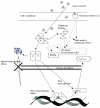Science review: mechanisms of impaired adrenal function in sepsis and molecular actions of glucocorticoids
- PMID: 15312206
- PMCID: PMC522845
- DOI: 10.1186/cc2878
Science review: mechanisms of impaired adrenal function in sepsis and molecular actions of glucocorticoids
Abstract
This review describes current knowledge on the mechanisms that underlie glucocorticoid insufficiency in sepsis and the molecular action of glucocorticoids. In patients with severe sepsis, numerous factors predispose to glucocorticoid insufficiency, including drugs, coagulation disorders and inflammatory mediators. These factors may compromise the hypothalamic-pituitary axis (i.e. secondary adrenal insufficiency) or the adrenal glands (i.e. primary adrenal failure), or may impair glucocorticoid access to target cells (i.e. peripheral tissue resistance). Irreversible anatomical damages to the hypothalamus, pituitary, or adrenal glands rarely occur. Conversely, transient functional impairment in hormone synthesis may be a common complication of severe sepsis. Glucocorticoids interact with a specific cytosolic glucocorticoid receptor, which undergoes conformational changes, sheds heat shock proteins and translocates to the nucleus. Glucocorticoids may also interact with membrane binding sites at the surface of the cells. The molecular action of glucocorticoids results in genomic and nongenomic effects. Direct and indirect transcriptional and post-transcriptional effects related to the cytosolic glucocorticoid receptor account for the genomic effects. Nongenomic effects are probably subsequent to cytosolic interaction between the glucocorticoid receptor and proteins, or to interaction between glucocorticoids and specific membrane binding sites.
Figures


Similar articles
-
Post-transcriptional and nongenomic effects of glucocorticoids.Proc Am Thorac Soc. 2004;1(3):255-63. doi: 10.1513/pats.200402-015MS. Proc Am Thorac Soc. 2004. PMID: 16113443 Review.
-
Genomic and nongenomic effects of glucocorticoids.Nat Clin Pract Rheumatol. 2008 Oct;4(10):525-33. doi: 10.1038/ncprheum0898. Epub 2008 Sep 2. Nat Clin Pract Rheumatol. 2008. PMID: 18762788 Review.
-
Glucocorticoid receptor function in health and disease.Clin Endocrinol (Oxf). 2015 Oct;83(4):441-8. doi: 10.1111/cen.12728. Epub 2015 Feb 24. Clin Endocrinol (Oxf). 2015. PMID: 25627931 Review.
-
Limited brain diffusion of the glucocorticoid receptor agonist RU28362 following i.c.v. administration: implications for i.c.v. drug delivery and glucocorticoid negative feedback in the hypothalamic-pituitary-adrenal axis.Neuroscience. 2006 Sep 1;141(3):1503-15. doi: 10.1016/j.neuroscience.2006.04.067. Epub 2006 Jun 27. Neuroscience. 2006. PMID: 16806720
-
Steroids and nitric oxide in sepsis.Front Biosci. 2008 Jan 1;13:1698-710. doi: 10.2741/2793. Front Biosci. 2008. PMID: 17981661 Review.
Cited by
-
Dexamethasone for Severe COVID-19: How Does It Work at Cellular and Molecular Levels?Int J Mol Sci. 2021 Jun 23;22(13):6764. doi: 10.3390/ijms22136764. Int J Mol Sci. 2021. PMID: 34201797 Free PMC article. Review.
-
Endocrine emergencies in critically ill patients: Challenges in diagnosis and management.Indian J Endocrinol Metab. 2012 Sep;16(5):722-7. doi: 10.4103/2230-8210.100661. Indian J Endocrinol Metab. 2012. PMID: 23087855 Free PMC article.
-
Comparative effects of recombinant human activated protein C and dexamethasone in experimental septic shock.Intensive Care Med. 2011 Nov;37(11):1857-64. doi: 10.1007/s00134-011-2327-9. Epub 2011 Aug 18. Intensive Care Med. 2011. PMID: 21850534
-
Corticosteroid Therapy Benefits Septic Mice With Adrenal Insufficiency But Harms Septic Mice Without Adrenal Insufficiency.Crit Care Med. 2015 Nov;43(11):e490-8. doi: 10.1097/CCM.0000000000001264. Crit Care Med. 2015. PMID: 26308430 Free PMC article.
-
Relative adrenal insufficiency is a risk factor and endotype of sepsis - A proof-of-concept study to support a precision medicine approach to guide glucocorticoid therapy for sepsis.Front Immunol. 2023 Jan 12;13:1110516. doi: 10.3389/fimmu.2022.1110516. eCollection 2022. Front Immunol. 2023. PMID: 36713379 Free PMC article.
References
-
- Waterhouse R. Case of suprarenal apoplexy. Lancet. 1911;1:577. doi: 10.1016/S0140-6736(01)60988-7. - DOI
-
- Friderichsen C. Nebennierenapoplexie bei kleinen Kindern. Jb Kinderheilk. 1918;87:109.
-
- Witek-Janusek L, Yelich MR. Role of the adrenal cortex and medulla in the young rats' glucoregulatory response to endotoxin. Shock. 1995;3:434–439. - PubMed
Publication types
MeSH terms
Substances
LinkOut - more resources
Full Text Sources
Medical

